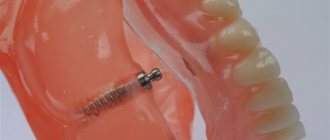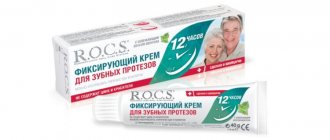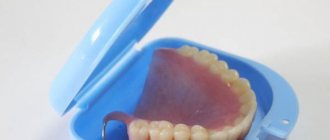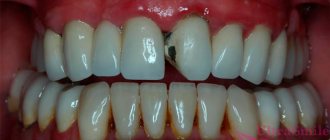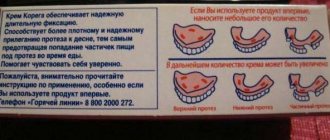What is a nylon prosthesis
Removable nylon dentures are soft orthopedic structures made of a pink, gum-colored nylon base with invisible clasps that hold it in the mouth. The fixation is on the adjacent teeth; the hooks wrap around the supports, keeping the prosthesis stationary on the jaw. Artificial crowns are placed on an elastic frame.
A person can take off and put on a nylon prosthesis without assistance. They are used in dentistry as a temporary solution during implantation (during the process of osseointegration) or as a permanent prosthesis according to indications.
Nylon is a polymer that has the quality of flexibility, and under certain conditions, in the patient’s mouth, softness increases. As a denture material, it has come as an alternative to dental acrylic, to which some people are allergic.
Partial nylon prosthesis RUR 40,000. for all!
The price includes: diagnostics, impressions, manufacturing, installation, fitting and 1 year warranty! Complete denture Akrifri 1 jaw - 47,000 rub.!
How to achieve a tight fit of dentures?
Your dentures are made specifically for your mouth and should be comfortable for you. If you've just started wearing dentures, your gums may feel a little sore - this is completely normal, and this feeling should go away as you get used to it. Here are some tips to help you speed up the adjustment period and feel more confident:
Give yourself time
Many people adjust to their new dentures immediately, but others may take several months to get used to the fit and feel of their dentures. By the time of your first visit to the dentist, you will probably have been wearing your new dentures for about a week. Often, when adapting to new dentures, mild discomfort and slight difficulties with speech may occur. But over time, your jaw and gums should adjust and you'll feel like yourself again.
Use denture fixation aids
Using Corega denture retention products will help you adapt to dentures more quickly. Denture retainers can improve your confidence when you eat, talk and smile, and provide a secure fit to help prevent particles from getting trapped under your dentures*. Thanks to this, you will be able to enjoy your favorite dishes again.
Take care of your dentures
Proper care of your dentures will reduce the chance of developing problems in the future. Place your dentures in a container of water at night to prevent them from becoming warped or out of shape.
A thorough denture cleaning routine is important—specialized denture cleaners, such as Corega Cleaning Tablets, remove 99.99% of the bacteria that cause bad breath** and keep your dentures fresh.
If pain occurs, consult a doctor immediately
As you get used to your new dentures, you may experience mild discomfort, which should subside after an adjustment period. If gum soreness persists for a long time, additional denture adjustments may be necessary. One small change can immediately make a significant difference in their usability.
…what if the denture becomes loose?
Even if dentures fit well, they can become loose over time. This occurs because the bone under your gums may shrink, causing the shape of your jaw to change. The dentist will be able to quickly detect and correct any problems associated with the use of dentures, which is why it is important to visit him regularly. By taking steps to maintain your dentures, you can continue to live life to the fullest without letting the little things get in your way.
Stages of manufacturing a flexible prosthesis
To create nylon dentures, you must first treat the teeth, perform removal according to indications, and then proceed to the following steps:
- taking impressions of jaws in a clinical setting;
- plaster models are made in the laboratory;
- a wax prototype of the prosthesis is cast, tried on, and finalized;
- a nylon final version is created, matched to the color of the gum. The equipment used is a heat press, in which polymer granules are melted and an individual mold is poured in a liquid state. After hardening, the structure is polished.
Clasps are a continuation of nylon dentures and are therefore completely invisible on the jaw even when smiling and talking.
How to quickly restore beauty to your teeth
Metal-ceramics, from which crowns are installed on the front teeth, are made in the traditional way with an impression. And prostheses made of ceramic or zirconium can be obtained in just 1.5 hours using Cerek technology. One anesthesia will be required, or you can do without it. The prosthesis is installed on a fresh, just prepared surface.
The technology is relevant for the production of metal-free crowns:
- The problem area is scanned and the model is reproduced by a computer.
- The anatomical dimensions and shape will exactly repeat the “native” tooth.
- The program will create a model and send the job to the grinding unit, where the design will be created.
If the shade is slightly different from the desired one, a new ideal copy can be easily created. A single crown is installed or an option is created for two front teeth.
Indications for installation
Indications for removable nylon dentures can be:
- loss of one or more teeth in a row;
- scattered defect;
- absence of all teeth;
- allergy to metal, acrylic;
- if you do not want to grind the supporting teeth for dentures, for example, clasp ones with locks;
- periodontal disease of 1st and 2nd degrees to keep teeth in place (but 3.4 degrees will already be a contraindication);
- patient refusal or medical contraindications to implantation;
- childhood, if necessary, hide early tooth loss;
- as a temporary solution for implantation with delayed loading.
Sometimes nylon dentures can be installed to treat bruxism, involuntary grinding in the mouth, which damages tooth enamel and increases wear. And also for athletes and people involved in traumatic sports, a flexible design is the best option, better than acrylic, which can easily break in case of injury.
Prosthetics with zirconium crowns –
The next option for aesthetic prosthetics of the front teeth is ceramic crowns made of zirconium dioxide (such crowns are called zirconium). This material has the strength of metal, and therefore crowns made from it do not require an internal metal frame. The absence of the latter should certainly provide more aesthetic options when using prosthetics with zirconium crowns, but in reality, not everything is so simple, and you can find a huge number of patients who are dissatisfied with such prosthetics.
Let's start with the fact that there are 2 types of zirconium crowns.
- The first option assumes that only the internal frame reinforcing the structure is milled from zirconium dioxide, which will then be covered with layers of ceramic mass (porcelain). The disadvantage of this option is that the porcelain often chips. According to statistics, after 3 years, chips occur in at least 6% of patients with zirconium crowns, and after 5 years – in at least 10% of patients.
In addition, if for this version of crowns a cheap version of zirconium dioxide blocks is used (milky white, not transparent, i.e. translucent), then even after applying layers of porcelain, the crowns end up looking unnatural, because have a milky tint.Clinical case No. 4 –
Note the unnatural color (no color gradient from the neck of the tooth towards the incisal edge of the incisors) that is present on adjacent teeth. In addition, there is no transparency of the cutting edges, i.e. crowns essentially look like plastic. Keep in mind that in most clinics in our country, zirconium crowns are made at approximately this low professional level.
- The second option is monolithic zirconium crowns “Multi-layer”. Monolithic - means that the crowns will be made entirely of zirconium dioxide, i.e. without applying layers of porcelain (accordingly, in this case there is no problem of ceramic chipping). But the most important thing is that in this case more expensive “Multi-layer” zirconium dioxide blocks will be used.
Such blocks have a gradient of color and transparency, which makes it possible to mill crowns from them, which will also have a gradient of color and transparency, varying from the neck of the tooth and towards the incisal edge. Accordingly, the presence of a gradient of color and translucency will make the crowns on the front teeth more similar to real ones.Clinical case No. 5 (multi-layer) –
In the photo above you can see newly made “Multi-layer” zirconium crowns, which still need to be fixed in the oral cavity. The crowns are made for the entire dentition - they are single crowns, with the exception of a 3-unit zirconia bridge in the side of the jaw (where you can see the artificial pink gum). Pay attention to the natural color and transparency that change - in the direction from the necks of the crowns to the cutting edge.
Is it worth it or not to make zirconium crowns?
Everything will depend on the specific situation in the oral cavity. In general, zirconium dioxide crowns are a good choice if you need to replace an entire group of front teeth at once (for example, 6-8 or more). This is because the dental technician only has a limited range of color options when working with zirconia. Those. If you have a complex tooth color, then one or more crowns will almost always differ from your neighboring natural teeth.
But this problem is solved if you do all the front teeth at once, in which case they will all look the same. And in this case, of course, you should pay attention to the fact that the crowns are made monolithic - from “Multi-layer” zirconium dioxide blocks, and not from cheap milky-white blocks that are not translucent. BUT, again, sometimes you have to deviate from this rule if the patient only needs 1-2 single crowns on the front teeth.
In this case, only the frame is milled from “Multi-layer” zirconium dioxide blocks, and then layers of porcelain are applied to it. Despite the higher risk of chipping, this technology will allow the dental technician to make crowns more similar to neighboring teeth, because When working with porcelain, the dental technician has a much wider range of color options. The main thing here is that cheap milky-white zirconium dioxide, which does not have translucency, is not used for the frame of the crowns.
The cost of zirconium crowns - the cost of 1 zirconium crown averages from 30,000 to 40,000 rubles. In the regions you can find prices starting from 25,000 rubles, but for this price the crowns will be made of cheap zirconium dioxide of a milky white color, which is not translucent. At the same time, we will next tell you about Emax ceramic crowns, the price of which averages from 25,000 to 30,000 rubles, and this despite the fact that they also benefit in aesthetics.
Zirconium dioxide with increased aesthetics:
Clinical case No. 6 –
Clinical case No. 7 –
When choosing ceramic zirconium crowns for your front teeth, you must ask your doctor for information about the manufacturer of the zirconium dioxide blocks from which your crowns will be milled. These should be translucent/pre-colored zirconium dioxide blocks (“multi-layer”) - preferably such as Katana® UTML (Japan) or Prettau® Anterior (Germany).
For more information about the various options for manufacturing zirconium crowns, read the article: → Options for manufacturing zirconium crowns, prices"
Contraindications
What may be a contraindication to a nylon prosthesis in dentistry:
- periodontal diseases (grade 3-4 periodontal disease), loose teeth, their displacement;
- recession;
- the height of the supporting teeth is not enough, the clasps will not be able to securely fasten;
- inflammatory processes of the mucous membrane and gums;
- tooth mobility;
- significant bone atrophy.
It is necessary to have healthy teeth on both sides of the prosthesis as supports for clasp fixation.
How much do the best dentures cost?
| Name | Cost, rub.) |
| Dental prosthetics with a complete removable plate denture | from 20,000 to 31,000 |
| Dental prosthetics with a complete removable plate denture made of nylon | from 50 000 |
| Dental prosthetics with a complete removable thermoplate denture Acry Free | from 49,000 to 55,000 |
| Prosthetics with removable clasp prosthesis | from 49,500 to 115,000 |
Varieties
There are:
- mini dentures for 1-2 teeth;
- partial (in the absence of three or more teeth);
- complete (replacing the dentition of the entire jaw).
Many people mistakenly believe that all flexible prostheses are nylon. This is wrong. They are very similar to the touch and in some characteristics. However, they should be considered separately.
Quadrotti prosthesis
A special modern type of prosthesis, which stands somewhere between clasp and nylon. It is more durable than the latter, has a little flexibility, and the fasteners are also not visible, unlike the clasp design, where, perhaps, this is the only drawback. The material of manufacture is monomer-free plastic.
Immediate prosthesis “butterfly”.
This is just a type of nylon prosthesis. It is used in cases where one, or less often, two teeth are missing. Small design, good replacement for a lost dental element. Produced quickly. The supporting teeth are not affected, that is, the doctor does not grind them down, they remain healthy and serve their term.
Conditionally removable dentures
To remove such products you need to make an effort. They are characterized by higher strength and comfort due to the fact that they are partially removable. Such designs include:
- clasp;
- quadrotti;
- New generation dentures without a palate.
Clasp dentures
Clasps are a classic version of conditionally removable dentures. They consist of four parts:
- directly the clasp itself, or a metal arch, which passes behind the teeth and serves as a support for the prosthesis on the palate;
- base - the base into which artificial teeth are mounted;
- teeth, or dental crowns (usually metal-ceramic, ceramic or zirconium crowns are used);
- fastenings
The photo shows a clasp prosthesis
There are three types of such designs:
- Clasps, which have claw-shaped hooks. This is the simplest, fastest and cheapest clasp prosthesis. However, they have a disadvantage: when prosthetizing the front teeth, the hooks can get into the smile area and be noticeable to others, so clasp clasp dentures are characterized by low aesthetics.
- Castle ones. One part of this structure is located on the tooth, and the other is in the prosthesis. They are attached to each other using a locking mechanism. Unlike the previous type, they are not noticeable in the mouth, but they have another disadvantage - depulpation and strong grinding of the supporting teeth are performed in order to install a prosthesis.
- Telescopic crowns consist of two telescopic crowns: internal and external. The first ones are made of metals (most often titanium or zirconium) and cover the supporting teeth with them. After this, the external ones made of plastic or metal ceramics are fixed. Here, as in the previous case, it is necessary to strongly grind and pulp the abutment teeth.
- An innovative version of clasps is splinting clasp dentures. They have a hook-shaped fastening that follows the individual shape of the tooth. Their main merit is in preventing the loosening of mobile teeth, therefore splinting clasps are recommended for patients with diseases of the oral cavity, such as gingivitis, periodontitis and periodontal disease.
Quadrotti
QuattroTi represents the next element in the evolution of prosthetic clasp products, in the manufacture of which no metals are used at all. The design is made of modern biocompatible Dental D plastic, which is highly flexible and durable.
Positive characteristics:
- the design is invisible in the mouth; in addition, it can be made transparent or painted in different shades of pink.
- the supporting teeth are not ground;
- the material is hypoallergenic;
- compared to clasp ones, the price is much lower;
- short adaptation period, since bioplastic does not rub the gums and does not affect articulation;
- physiologically correct distribution of chewing load is maintained.
There is one disadvantage - a short service life, which ranges from 3 to 5 years.
The photo shows the “Quadrotti” prosthesis
Without a palate
A new generation of palateless dentures, or sandwich dentures, were invented in Moscow. They are used for partial edentia. Such crowns consist of three parts:
- acrylic base;
- artificial teeth are also made of acrylic;
- telescopic crowns, or retainers, which are made of polyurethane.
This is the disadvantage of sandwich structures: they are made of materials with reverse properties. Hence their special name “sandwich”.
Polyurethane retainers are stretched over the remaining teeth and firmly hold the entire structure, thus ensuring minimal impact and damage to healthy teeth, which is why they are called palateless dentures (they are attached only by adjacent teeth).
The photo shows a prosthesis without a palate (sandwich)
Some patients consider the negative aspects to be the high cost and frequent occurrence of allergic reactions to acrylic and polyurethane. In addition, polyurethane is a fairly thick material, so sandwich dentures prevent the natural closure of teeth and are noticeable when speaking.
Rules of care and wearing features
In order for the prosthesis to look aesthetically pleasing throughout the entire period of use, you should adhere to simple rules for caring for it:
- brush your teeth and teeth 2 times a day;
- the toothbrush should have soft bristles and the toothpaste should be non-abrasive;
- After each meal, also clean the product or rinse your mouth with water if it is not possible to remove and thoroughly wash the denture;
- take it to the dentist for professional cleaning twice a year;
- do not store in a dry place;
- periodically use a special solution to disinfect and clean removable dentures.
Possible consequences
The longer a patient uses a prosthesis characterized by an unstable position, the more serious the consequences for his health may be. Potential complications include:
- Constant physical and psychological discomfort associated with displacement of the structure while eating or communicating with others;
- Damage to the oral mucosa caused by rubbing or biting;
- Impaired diction, as well as distortion of natural facial proportions;
- Regular entry of food particles into the area between the prosthesis and the base, which results not only in the formation of pathogenic microflora, but also in disorder of the digestive system;
- Possibility of failure of the replacement structure;
- The need for constant adjustment of the position of the removable denture.
In such a condition, it is difficult to talk about restoring the aesthetics and functionality of the jaw, therefore, at the first signs of a fixation disorder, it is recommended to contact your dentist.
Advantages
An undoubted advantage is the aesthetic appearance, better than that of acrylic and clasp structures. And:
- light weight, which is a significant factor for the upper jaw, where a person feels every gram of a foreign body;
- small basis. There is no wide part blocking the sky, like the plate analogue, which is much more comfortable;
- quick addiction is due to the two points above;
- “invisible prosthesis”, invisible to others, a person can laugh and talk without hesitation. Nylon, in this sense, is a good material; it perfectly imitates gums. And since the clasps are a continuation of the base and are of the same color, they are attached directly to the gums behind the supporting tooth, so they are not visible. What is an advantage over metal visible hooks of clasp structures and acrylic ones;
- hypoallergenic. The production does not use toxic monomers that are added to the plastic mass of acrylic prostheses. They are the ones who cause allergies in patients. By the way, other alternatives to prosthetics have appeared for such sensitive people - Acry Free;
- there is no metallic taste in the mouth due to the absence of metal in the composition;
- The next plus will be felt by people who have a small mouth. Opening it wide to install a large prosthesis is not very comfortable. But not in this case. Nylon bends easily and does not require such sacrifices from patients.
Flaws
It cannot be said that all the disadvantages that we describe below apply to mini-prostheses. They are the ones who receive the least number of complaints. But larger designs definitely have the following negative nuances:
- uneven load when chewing and discomfort when chewing food. The base is flexible and when bitten it bends even more, all the pressure goes to one area, which causes pain. Since the load is not distributed over the entire prosthetic bed, the tissues underneath it atrophy;
- rapid atrophy. Under any removable denture this process occurs and the height of the alveolar ridge is lost. You can find figures about 1mm per year. Loss of tissue leads to subsidence of the prosthesis;
- damage to the gums in the area of clamp fixation. Unlike the clasp type and the plate type, where the hooks wrap around the neck of the supporting tooth, nylon dentures have a gingival attachment. Therefore, the load when chewing is transferred not to the tooth, but to the gum, which over time injures it;
- a fairly rapid decline in aesthetics. Nylon scratches, becomes sticky over time, and attracts dirt;
- beyond repair;
- short service life - up to 5 years and at the same time the need for frequent corrections.
Types of removable dentures in complete absence of teeth
Plate acrylic
Classic acrylic insert jaws are made of hard plastic. Fixation is ensured by a wide lamellar base. When biting, air comes out from under the base and a suction effect occurs. Pros: affordable price, maintainability, aesthetics. The disadvantages include deterioration of fixation as the contours of the prosthetic bed change with the need for relining, large sizes, and the need to adapt to the device. Plastic contains monomers that can cause allergies. Artificial teeth absorb dyes and odors, and after 2-3 years they lose their aesthetic properties.
Acry-Free
Monomer-free plastic Acri Free, produced in Israel, is more elastic than acrylic and does not cause allergies. Products from it are made using the injection molding method, which ensures precise fit of the base to soft tissues, as well as tight fixation. The compactness and translucency of the artificial gum make the false jaw convenient, comfortable, and aesthetically pleasing. The resistance of the structure to chewing loads prevents damage to soft tissues and also somewhat slows down atrophy. Orthopedic devices from Akri-Free are recognized as the best alternative to plastic false jaws, but they cost more.
Nylon
The main characteristic of the material of nylon prostheses is elasticity. The base is thinner, softer, and more compact than plastic, which makes false teeth comfortable for the patient. The translucency of the base ensures aesthetics. However, softness is also a disadvantage of nylon. The base quickly loses its shape, which negatively affects fixation. The device cannot be repositioned. During chewing of food, the load is not distributed, but is locally transferred to soft tissues, which causes pain in patients. The porous material absorbs dyes and changes the smell.
Expert opinion
Roman Borisovich Alekperov
orthopedic dentist
Experience: 24 years
The choice of flexible prostheses is based mainly on the patient’s desire to receive maximum comfort from wearing an orthopedic structure. Nylon or silicone prostheses do not require long-term adaptation - made from an individual cast, they immediately sit comfortably and allow you to chew food and speak normally. It is important to remember that long-term wearing of flexible prostheses can lead to the development of atrophic processes in bone tissue, since these structures do not have a rigid base. Do not use flexible dentures for more than 6-9 months if you are planning to have implants. If such a situation occurs and the bone is “gone,” it will be necessary to pre-build it or perform basal implantation.
What to do?
- Contact a specialist for advice and help;
- Adjust the design or order a new one;
- Find another prosthetic option.
In general, each specific case has its own individual solution. For example, if teeth are completely missing, you can use acrylic or nylon dentures. They are perfectly attached due to vacuum, sticking to the gums. A high-quality prosthesis does not require the use of special creams. However, in patients with atrophied bone tissue, when moving the jaw, air can get under the prosthesis, breaking the vacuum. In this case, two implants are placed, and the structure is held securely.
If not all teeth in the mouth are lost, but the upper denture, which is conditionally removable, does not hold, there is a solution for this too. Such designs can be plate, nylon, or clasp. They are fixed with clasps, hooks, and gingival processes. If the structure is unstable, you just need to tighten the fastening. But you can’t do it yourself, you might accidentally break it. You can only trust the work to a doctor.
Examples of work “Before” and “After”
Partial restoration of teeth on both jaws
Case: partial absence of teeth on both jaws.
Complete prosthetics of the upper and lower jaws
Case: absence of teeth in the upper jaw (completely), absence of an orthopedic structure in the lower jaw on existing implants (installed in the USA two years earlier) Work: production of a complete removable denture in the upper jaw as a temporary structure until the installation of one-stage implants with subsequent prosthetics.
Installation of plate dentures with complete edentia (April 2012)
Case: complete absence of teeth in the upper and lower jaws, weak fixation of the removable denture in the lower jaw.
Complete absence of teeth in the upper jaw
Case: Completely edentulous upper jaw Work: Complete removable plate denture - acrylic Number of visits: 4 Time: 2 weeks Cost: 25,000 rub.
Alternatives to implantation
If there are no teeth in the lower jaw, or some of them are in poor condition and must be removed, prosthetics can be done using a removable structure. Modern dentures are made from soft plastics; they are fixed quite well on the gums, fitting tightly to the mucous membranes. However, compared to dentures that are fixed on implants, removable structures are more massive, take a long time to get used to, and over time become a little “loose” - due to the risk of falling out, the patient has to additionally use dental glue.
The second option is to install a dental bridge. The denture is permanent, but its fixation requires at least two living teeth in good condition. They are turned down, since the crowns that are part of the dental bridge are fixed on top. The prosthesis is comfortable and aesthetic. But the teeth of the lower jaw bear an increased load, so bridges do not last long - the supporting teeth are destroyed, which most often cannot be restored.
The main disadvantage of removable and bridge prostheses is the lack of load on the bone. They restore only the visible, crown part of the tooth, and the bone tissue, as in the absence of teeth, ceases to receive load - the process of its atrophy continues. This is fraught with subsidence of the prosthesis along with the gums, as well as the appearance of a small gap under it, in which plaque accumulates - this is a direct path to inflammatory processes of the periodontium.
1 According to the International implant foundation.2 According to clinical studies from Nobel, Straumann, International implant foundation.


